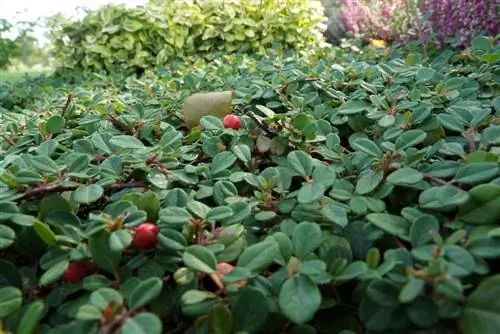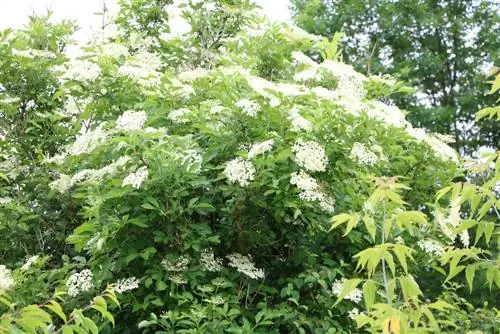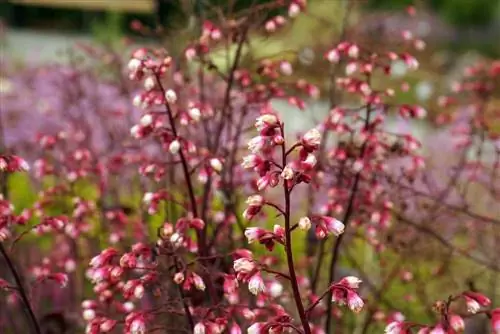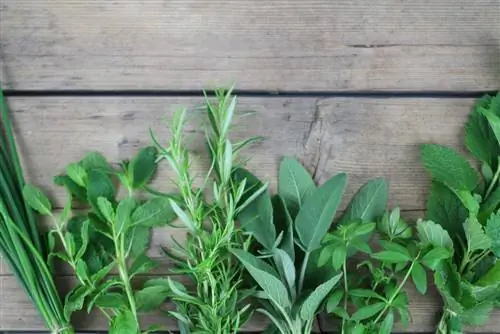- Author admin [email protected].
- Public 2023-12-17 03:39.
- Last modified 2025-01-24 12:45.
Shade plants do not thrive in sunny places. They are often characterized by lush foliage. With the right flowers, a shady spot can also become a lushly blooming oasis, as many shade flowers have extremely decorative flowers. Perennials in particular cope well with the shade. With a little planning, you can have a blooming ensemble of shade plants throughout the entire season. In addition to flower bulbs, which you can plant in autumn, annual flowers and grasses and perennials are suitable for the shade garden.
Not all shadows are the same
Shadow is divided into a deep shadow without any sunlight and a light partial shade. Deep shade is created under trees whose canopy blocks the sun's rays, on northern terrace corners or behind privacy walls and on north-facing balconies. Locations that are touched by the sun in the morning and evening and have a sunshine duration of around three hours are considered semi-shady. While many foliage plants provide an interesting sight in the shade, several types of flowering plants also thrive in partial shade. A misconception is that shaded areas require less watering. Just the opposite is the case.
Tip:
Shade plants with large leaves and hydrangeas have an increased water requirement!
Planting suggestions for partial shade
The wood anemone is an early bloomer for partial shade between late-blooming perennials and trees. It blooms with small white flowers and yellow flower centers from March to April and forms dense plant carpets with runners. The wood anemone grows to a height of 10 cm to 15 cm.
- The woodruff is a ground cover plant. It grows in partial shade and produces clusters of white flowers between May and July that exude an intense scent. The perennial grows to a height of around 40 cm and loves calcareous soil.
- The liverwort forms a blue carpet of flowers in partial shade. It is an early bloomer and blooms in February to March. The liverwort sows itself and soon forms dense carpets of plants. It is around 10 cm high.
By the way: Rhododendron fills the partial shade with its decorative flowers in many color variations. The hardy cyclamen also blooms in partial shade until winter and hydrangeas with their decorative flower balls feel comfortable in partial shade.
Tip:
Anemones can be planted in partial shade and shade.
Planting suggestions for shade

The shadow area doesn't have to be dreary and desolate. Many flowering plants add color to the garden. Lily of the valley, wild garlic and cranesbill, violets and dead nettles survive without sun.
- The Japan mock anemone with lovely white flowers grows on moist, humus-rich soil that is not too calcareous. The perennial blooms between July and August.
- Aquilegia produces delicate bell-shaped flowers between May and June in a delicate purple. The perennial grows to a height of between 30 cm and 40 cm and thrives best in humus-rich soil with little lime content.
- The hanging goldlock thrives in the shade under trees and bushes. With delicate yellow hanging bell-shaped flowers, the perennial forms dense clusters. It grows to a height of 30 cm to 40 cm.
Other decorative shade plants include the heart lily with lilac-colored flowers, the foxglove in purple, blue, yellow, pink or white and astilbe with fiery red feather-like inflorescences.
Decorative leaf plants
Decorative foliage plants for shade and partial shade can do without colorful flowers. These include the group of ferns with decorative leaf fronds. The leaf color varies from lush green to reddish brown or gray. The hosta also has decorative leaves in green and white. It grows up to 50 cm high. In addition to the decorative leaves, the hosta produces delicate purple flowers between June and August. Ivy is a climbing plant for shady areas. The fast-growing plant is suitable for adding greenery to shady house walls.
Create a shade garden
Plan shrubs, climbing plants and flowering perennials for your shaded areas. Place the taller growing trees and perennials in the background. The areas become interesting when the flowering phases of the individual perennials alternate. Snowdrops, liverworts and Christmas roses bloom first. In the summer months, star umbels, cherries and the Japanese toad lily bloom in the shade. The cyclamen shines in the shade garden until winter. To ensure that the different perennials grow together well, perennial plants that can be enhanced with decorative grasses should be selected for the shaded area.
Color compositions for the shadow
- green leaf ornamental plants fit everywhere
- white flowers look fresh and neutral
- Yellow and organs conjure up warm reflections in dark corners
- Blue and violet in combination with white ensure refreshing coolness
A herb garden in the shade
Shadow herbs have a fresher, stronger aroma than sun-drenched herbs. Parsley, peppermint, chili, chervil, borage, lovage and tarragon thrive in light shade just as well as watercress, rocket, chives and garlic mustard. Mediterranean herbs such as thyme or rosemary are not shade plants. Herbs in the shade require humus-rich soil. If you want to plant these under trees or bushes, we recommend improving the soil with compost or fertilizer. Woodruff, lemon balm and mint are among the rapidly multiplying herbs. They require a lot of space.
The seat in the shade
Incorporate a seat into the shade, which you frame decoratively with shade plants. The result is a retreat for the hot summer months that benefits from the shade plants with a pleasant climate and the herbs with an intense scent. An easy-care hedge made of cherry laurel or rhododendron frames the retreat. Also plan on ground cover. They prevent weeds from growing. In addition, shady areas can be enhanced with water features and garden decorations.
Frequently asked questions
Which early bloomers are still blooming on the shade bed?
This also includes grape hyacinths, march cups and dogtooth.
How to propagate ferns?
Ferns develop breeding nodules. These form on the underside of the leaf along the midrib and are fully developed from late summer onwards. Proceed as when propagating with sinkers or separate the areas with the knife and plant them in a plant pot.
Which grasses harmonize with ornamental foliage plants?
Japanese grass is an option for partial shade. In the sun it yellows and in dense shade it turns green. Japanese grass grows to a height of 30 cm to 60 cm. The giant sedge forms overhanging seed heads, which are a decorative sight even in winter. It grows up to 140 cm high.
More shade flowers and plants
Hardy evergreens

If you don't necessarily want flowering plants as shade flowers, evergreen leafy plants are recommended. Boxwood, a tree that can be cut into a variety of shapes, is ideal for such locations. It doesn't need sun. You can buy it in many different sizes or grow it yourself. It is also particularly beautiful as a standard tree. This version has the advantage that it can still be planted with blooming flowers. The evergreen privet and small-leaved Ilex species such as the columnar Ilex are just as suitable. The creeping spindle also usually copes well with shady locations. The varieties with white and variegated leaves are best. The yew also likes shade and can be easily shaped. The yellow-needle varieties do particularly well there.
Leaf Plants
Leafy plants such as ferns and hostas are grateful potted plants for shady locations. Hostas also often bloom quite conspicuously. Purple bells (Heuchera) also make good shade plants. They impress with their striking foliage. The flowers are usually unspectacular, but the colorful, eye-catching leaves need no additional decoration. Heucheras come in many colors, from various shades of green to light and dark red to orange. Many also have grained or patterned leaves, real gems that don't require much care. In winter, many leafy plants die or they are no longer as attractive.
Hardy flowering plants
Rhododendron, hydrangeas (with winter protection), golden felberry, astilbe are among the shade plants that usually survive the winter quite well. A little winter protection doesn't hurt and can also be quite decorative if you think of something.
Non-hardy flowering plants
Fuchsias are probably the flowering plants that do best in shady locations. They come in many colors. The varieties with the almost fist-sized flowers are particularly beautiful, but they are also a bit more sensitive. Fuchsias need good winter quarters if they want to delight them with their countless flowers next year. Beautiful mallow, Japanese aukube, begonias, angel's trumpet, camellias, many varieties of clematis, feather bush, some hydrangeas, busy lilies, mountain laurel, petunias, laurel loquat, primroses, gentian bush, gentian tree, beautiful leycesteria and firethorn are also suitable. Some shade flowers can also be placed in a sunnier and brighter place, but they are quite frugal and can also cope with shade.
Conclusion
A standard box or something similar is best suited for a shady entrance area. Since the thin trunk leaves a lot of space in the pot, you can use flowering seasonal plants. For example, you use primroses in spring, busy lilies in summer, colorful heucheras in autumn and colored or white Christmas roses in winter. This means you have beautiful decoration at the entrance to your house all year round.






